
11 minute read
An Insider’s Look: The Clifton Smith Herbarium
By Annie Ayers, Herbarium Collections Manager; Isabella Salangsang, Herbarium Technician; Jessica Spaw, Herbarium Technician; and C. Matt Guilliams, Ph.D., The Ken and Shirley Tucker Plant Systematist and Curator of the Clifton Smith Herbarium
An herbarium is a natural history museum that houses dried, preserved plant specimens. This simple function belies the critical and enduring importance of herbaria as active repositories of biodiversity knowledge and hubs for conservation activity worldwide. Specimens in herbaria are the basis for understanding Earth’s plant biodiversity. Each of the world’s named plant species can be traced back to the study of specimens in herbaria, and herbaria worldwide contain specimens representing species yet to be described. Plant conservation too relies upon specimens and their associated data as the gold standard for scientific evidence, informing planning and decision-making in all levels of society. It is impossible to overstate the historical, present day, and future value of herbaria.
The Clifton Smith Herbarium at Santa Barbara Botanic Garden was established in 1939, but it contains a record of local plant diversity that stretches back to Santa Barbara’s earliest days as a town. The Garden’s oldest specimen was collected by William Brewer in 1861 during the span of the first California State Geological Survey. The Herbarium has grown considerably since its founding, expanding to a bustling, modern collection of over 160,000 pressed plants. Our specimens have been used for countless studies and are the starting point for many critical resources, one of which is the book “A Flora of Santa Catalina Island,” currently in its publication phase.
So, how do plants in their native environments become preserved specimens that can last in perpetuity in herbaria? Let's go through it, step by step.
Steps of Herbarium Processing
1. Permitting
When on public land, whether state or federal, permits are required to collect plants and other kinds of biological samples. Additionally, when plants are protected as rare or endangered, we must obtain permits through state and federal agencies to ensure these special plants don’t go extinct.

2. Pressing specimens in the field
We venture out into the field armed with soft plant presses, tools to remove plants, newspaper to store and press each plant, as well as field notebooks and writing utensils to record information. We focus on collecting flowers, fruits, seeds, and leaves to ensure that the specimen has all informative plant parts for later study. We press the specimen between sheets of newspaper.
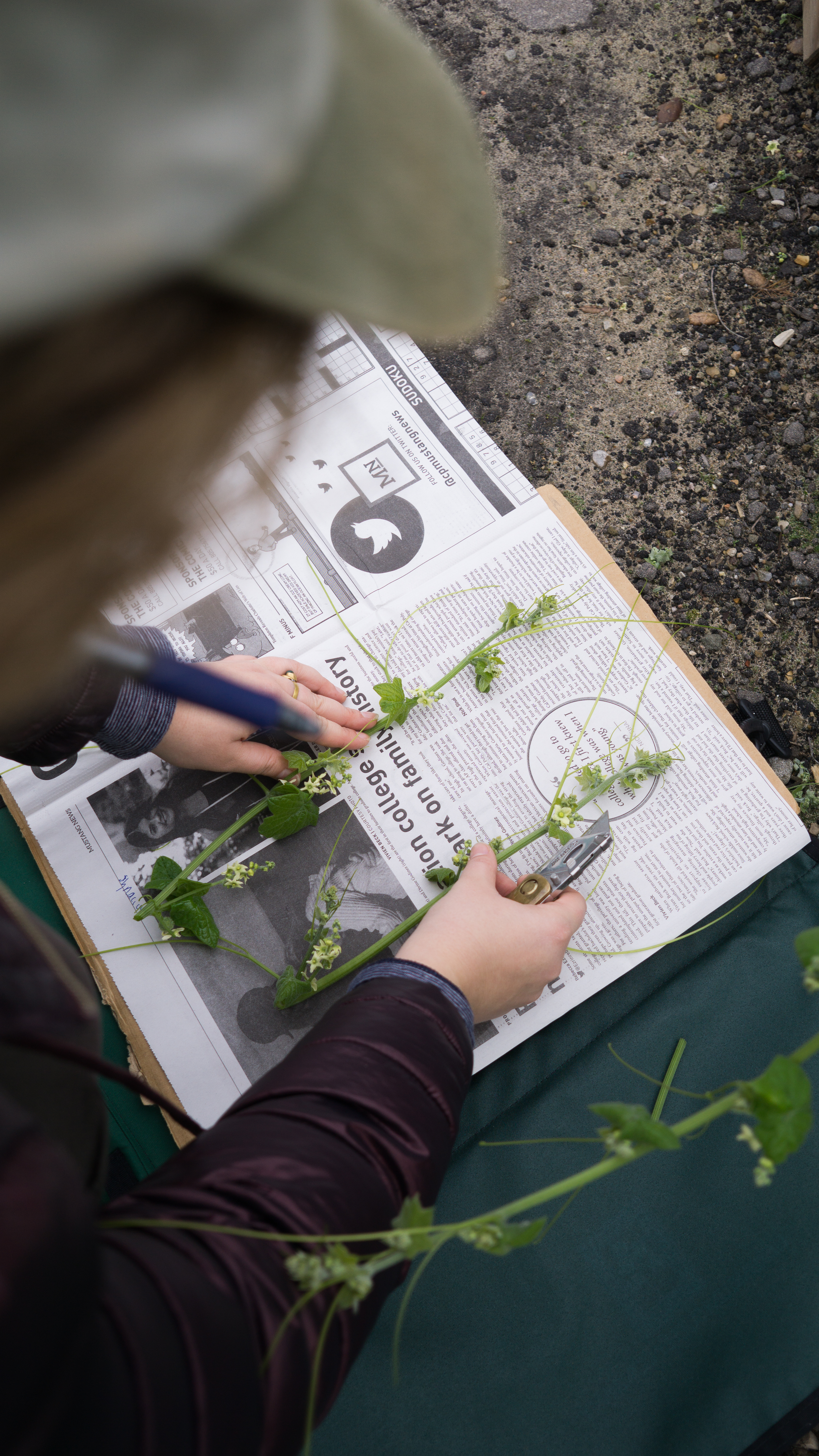
3. Recording field notes
In our field notes, information about the specimen is recorded. This includes the date of collection, the geographic location, and habitat information. We additionally include descriptions of the specimen itself (which may be lost in the drying process) such as flower color, height, overall plant architecture, etc.
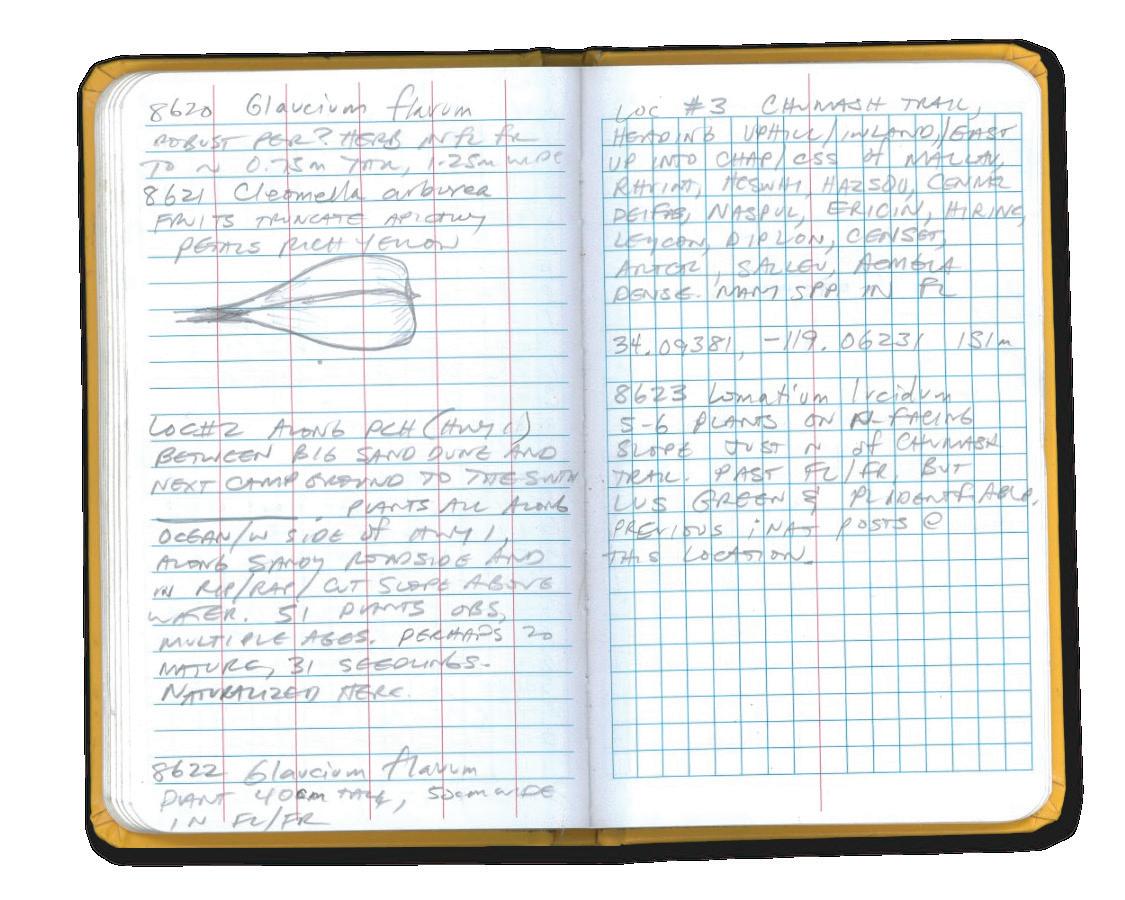
4. Drying specimens
Assuring the plant material is thoroughly dried is vital to the collection process; dehydrating the plant material prevents decomposition, consequently preserving much of its color and form. This allows us to mount the plant for storage for as long as possible with as many of its original features preserved as possible.
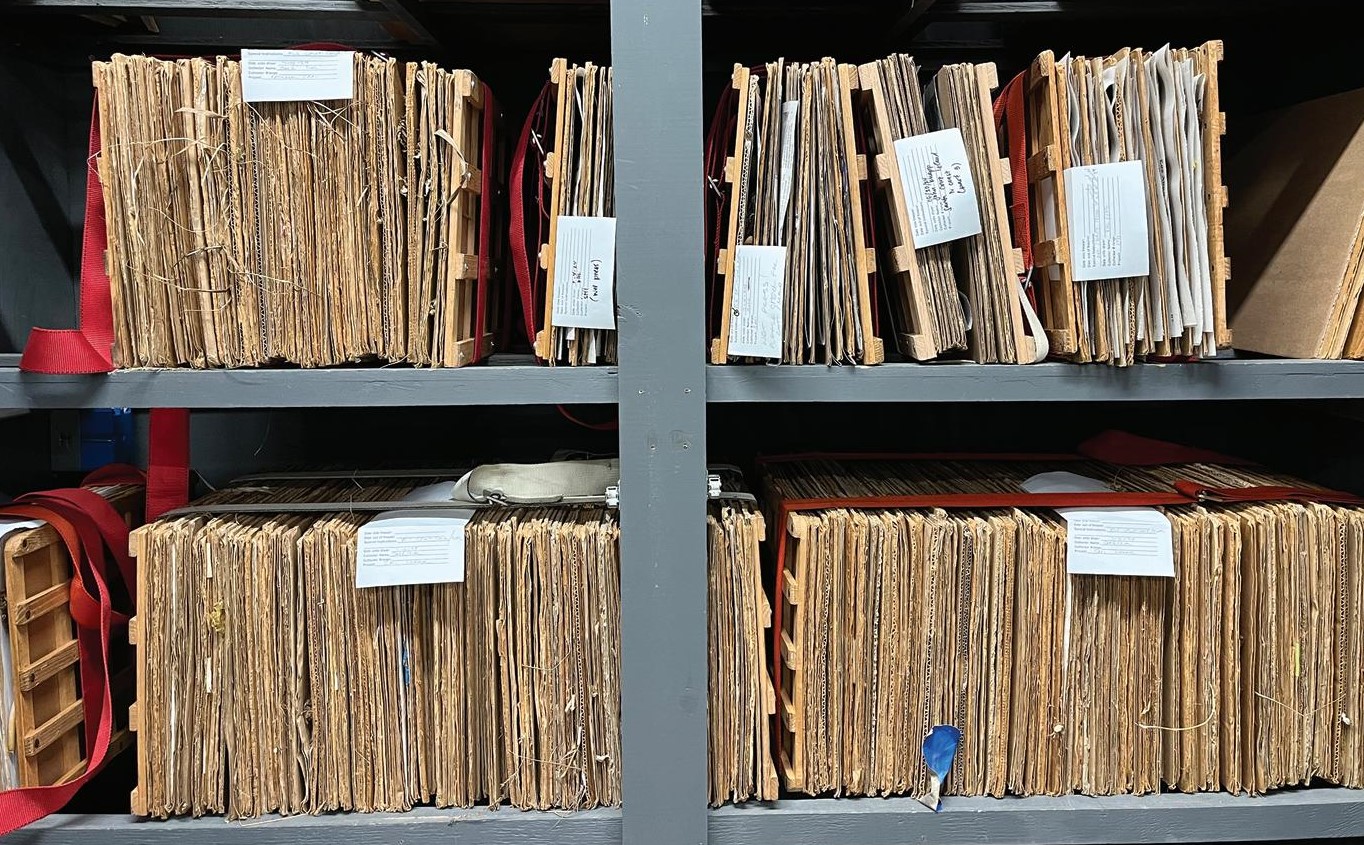
5. Identifying
Many plants are collected without knowing exactly who they are first, or in scientific terms, to which taxa they belong. Certain structures, such as seeds need to be examined under a microscope for accurate identification. This process is also referred to as "keying" as a botanical key is necessary for accurate plant identification.
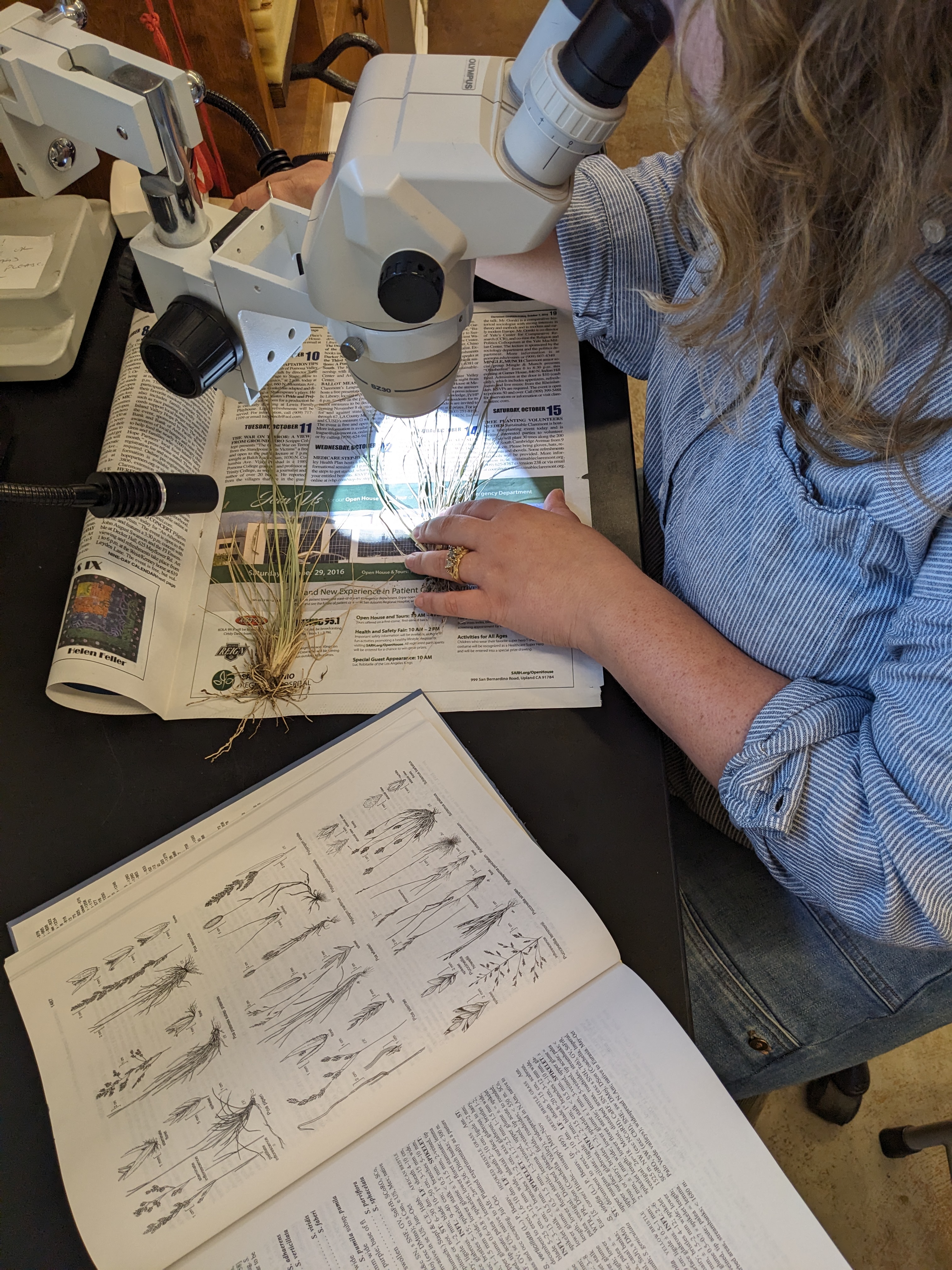
6. Transcribing field notes
Once the field notes are scanned, transcribers pore through the handwritten notes and parse the information into their appropriate fields in the Consortium of California Herbaria Portal 2 (CCH2) — the main database of herbaria in California. Each individual plant collected gets their own record of occurrence in the database, containing all the important observations pertaining to that specimen made by the collector in the field.
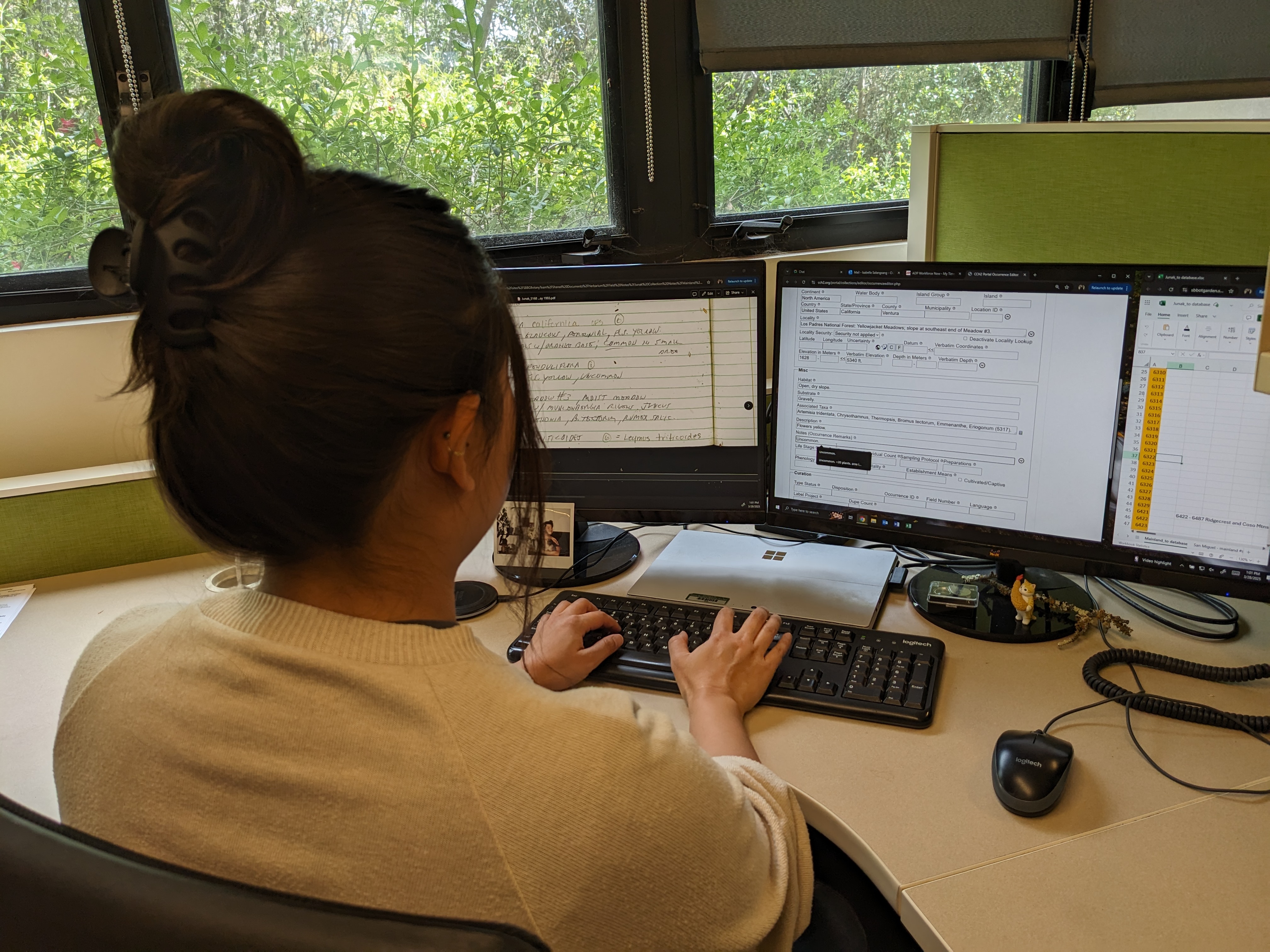
7. Creating labels
In its final form, each CCH2 record becomes an herbarium specimen label. After a rigorous proofreading process, labels are then printed onto archival paper, manually cut to size with our sharpest paper cutter, and united with the specimen they describe.

8. Mounting Specimens
We make sure important plant structures are intentionally displayed for future examination, optimizing the display of flowers, fruits, leaves, and other important features. Mounting specimens is like creating artistic masterpieces with scientific merit.
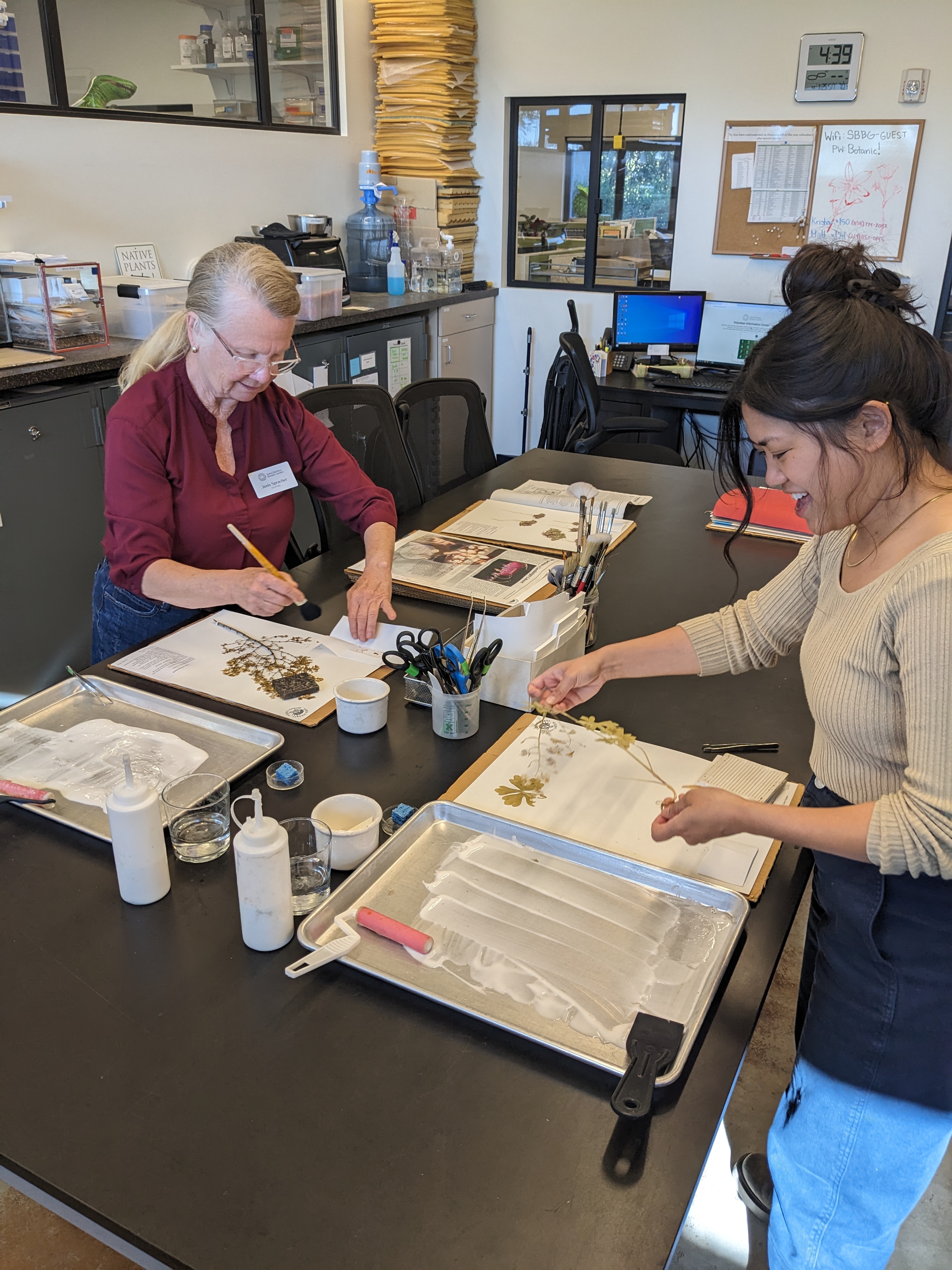
9. Freezing
Before newly mounted specimens may enter the Clifton Smith Herbarium, they must be frozen to minimize hungry pests that may hitchhike into our collection and cause damage, similar to how moths munch your clothes or weevils eat your baking flour. Our prime pest suspect is the cigarette beetle (Lasioderma serricorne), so named for its history of eating the tobacco out of cigarettes.
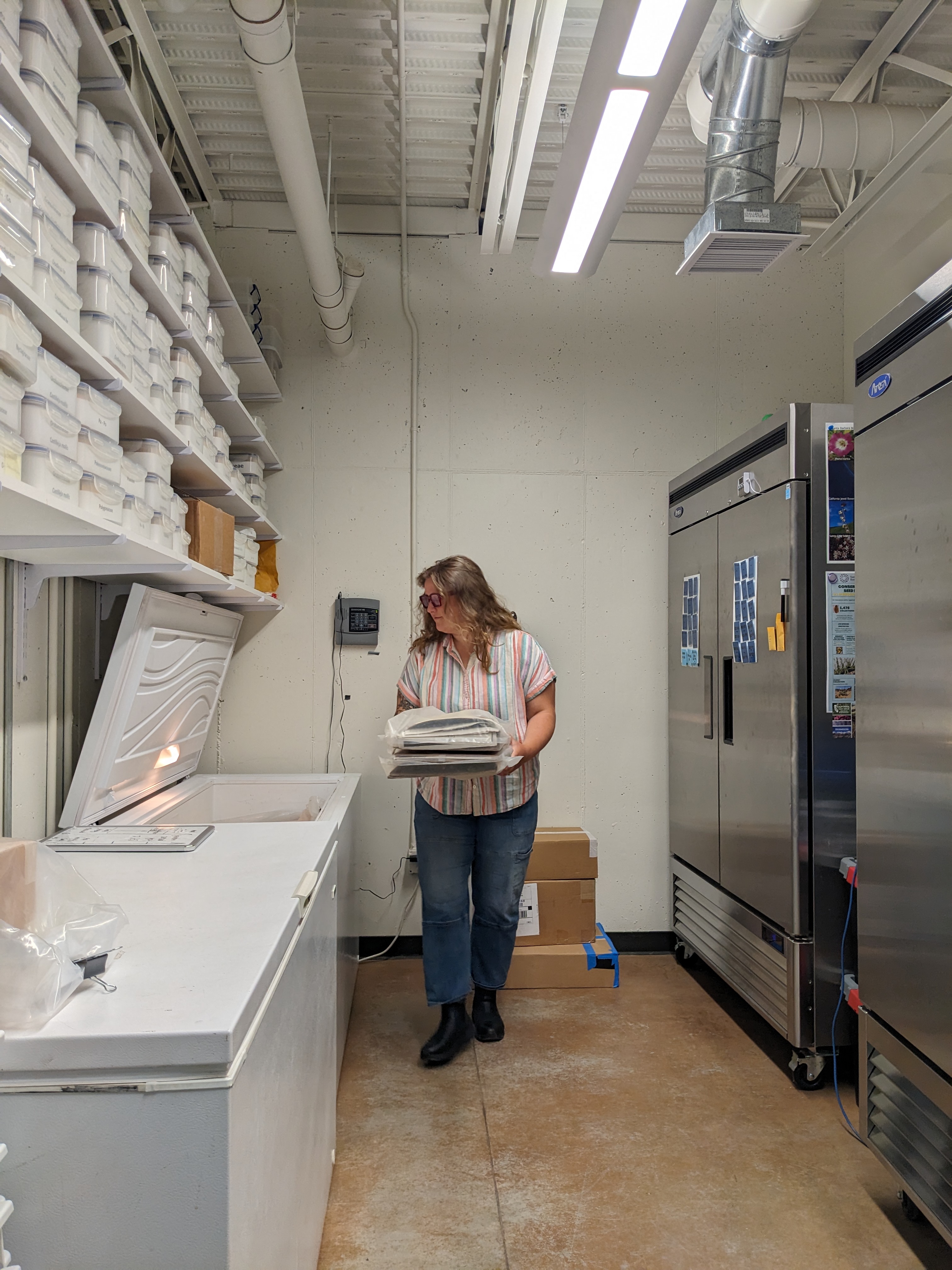
10. Entering the Herbarium
We take many precautions to keep our collection safe! The Herbarium is located underground to protect the museum from natural disasters. In addition, the double-door entry system allows for an extra layer of safety from fire, pests, and moisture.

11a. Reflecting our Herbarium in the digital realm
While the physical specimens live in our Herbarium, their complimentary digital records live online on CCH2. This gives worldwide access to our specimens via the internet.
Globally, organizations have begun digitizing biodiversity collections for posterity, redundancy, accessibility, and improved data analysis. With over 160,000 specimens already in the Clifton Smith Herbarium alone, and hundreds more flowing in each month, digitizing each historic and incoming specimen is a big job. Luckily, we have a fleet of dedicated volunteers who help.

11b. Databasing
For specimens not in CCH2, a databaser will transcribe label data into a new CCH2 record. This meticulous and precise task involves interpreting label data and typing the corresponding information into the appropriate CCH2 fields.

12. Barcoding
Every mounted specimen must be given a unique Santa Barbara Botanic Garden barcode sticker, which acts as our museum catalog number. Much like the barcode on your groceries, each sticker is easily read by a camera or handheld scanner, saving time and reducing human error. Once a barcode sticker is applied to a specimen, the number is scanned into the corresponding CCH2 record, linking the physical to the digital and allowing us to track our collection with ease.

13. Imaging
No digital specimen record is complete without a high-resolution image. Photographing thousands of specimens efficiently is made possible by hours of volunteer time and a barcode system, custom light box, and camera rig.

14. Filing
Once specimens have been databased, barcoded, and imaged, they are filed into our state-of-the-art storage cabinets for centuries to come.

How Are These Meticulously Preserved Plants Used?
While processing is completed after a specimen is filed, the journey doesn’t stop there. Specimens are regularly used by biologists, geneticists, and conservationists around the world. Between 2021 and 2025, the Clifton Smith Herbarium has been cited in over 570 scientific papers. Some recent papers include the following:
• “Global availability of plant DNA barcodes as genomic resources to support basic and policy-relevant biodiversity research” from researchers in Rhode Island
• “Herbivory and climate as drivers of plant population and range dynamics” from researchers in British Columbia
• “Potential effects of climate change on cacti distribution and conservation in North American drylands” from researchers in Brazil
• “Continental-scale empirical evidence for relationships between fire response strategies and fire frequency” from researchers in Australia
By capturing specimen data and putting it into worldwide data repositories, the Garden’s herbarium serves a global audience.
The power of herbaria is utilized in many ways. Its primary use is in the science of classifying and naming organisms, known as the practice of taxonomy and systematics. The taxonomic journey can take years — decades even. Often, new plant species are sitting in herbarium cabinets waiting for experts to look closely and “discover” their uniqueness. In fact, 84% of new plant species are described from specimens that are over 50 years old (Bebber et al., 2010, 22169-22171). The specimen acts as a nomenclatural standard or “type” — a legally official and scientist-verified example of the species.
The physical samples of material in herbaria serve other functions. By sampling leaf tissue from specimens, we can explore the genetic code of the plants and construct family trees to understand how plants are related to each other. Over the last 20 years, technological advancements have greatly improved our ability to construct these family trees. We do this across plant families, across genera, or even across populations. While this is helpful in the quest to understand biodiversity in a general sense, these techniques can also be applied locally, for example, to help us answer questions about how plants on the Channel Islands are related to each other. Our organizational partners such as The Nature Conservancy or the National Park Service use herbaria samples to manage the ecosystems in their care.
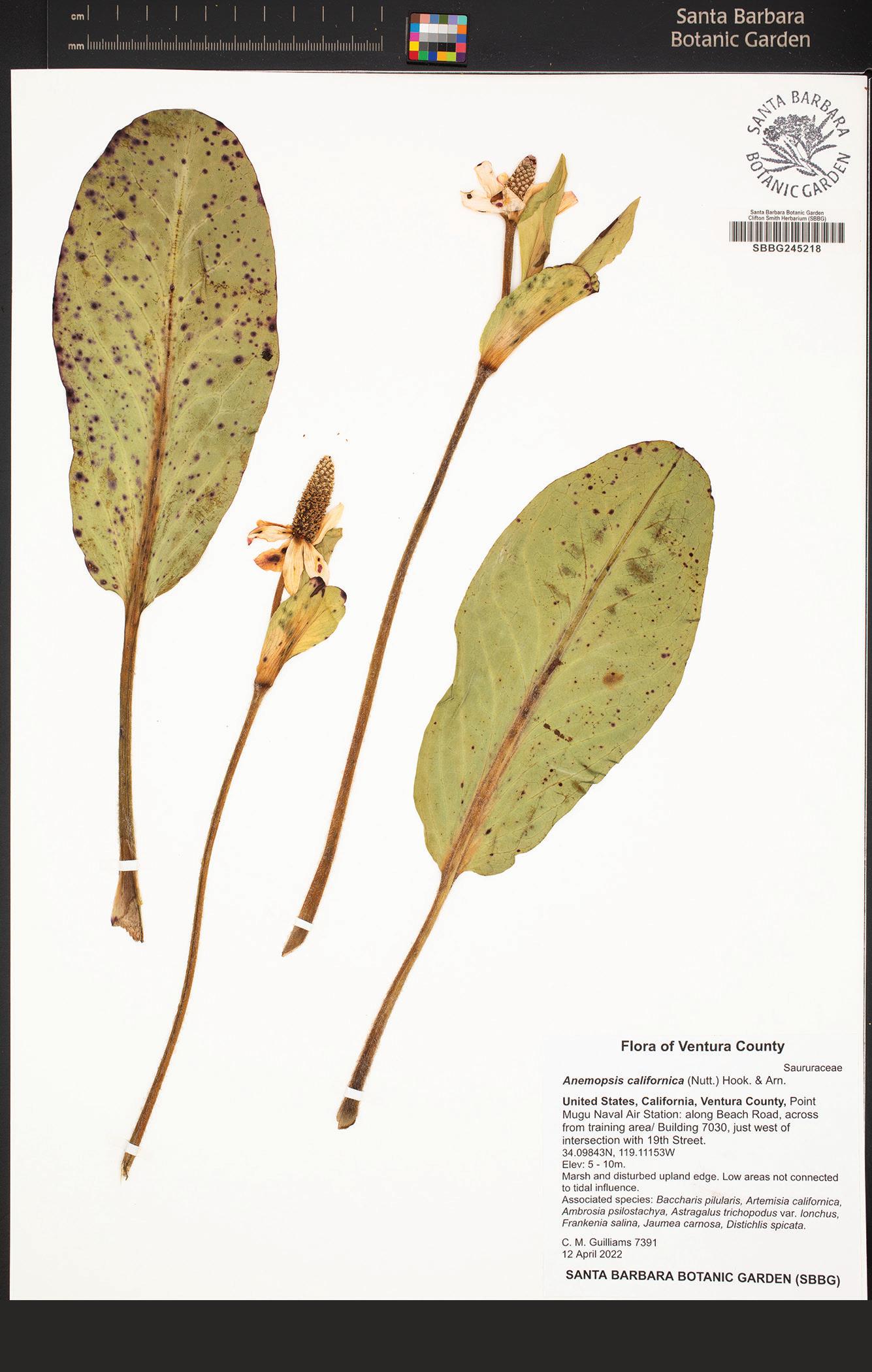
In addition to harboring yet-to-be-known plants and housing genetic material, herbaria act as reference libraries for our local flora. Many plants are cryptic. Having an imaged reference library allows communities to better understand how to differentiate closely related species.
Sharing information among herbaria and other natural history collections has become critically important as biologists and conservationists meet the challenges of our time. For example, global data sharing can help us understand the distribution of life on Earth by compiling observations from many hundreds of museum collections. By aggregating these data, we can start to see patterns of range and distribution, which in turn inform conservation efforts such as replanting after forest fires or identifying region-specific native plants for restoration. Also, this documentation is valuable when tracking the spread of invasive species, or the contracted ranges of endangered ones.
Herbarium specimens additionally act as vouchers and backups for other critically important work that is being done at the Garden. When our rare plant biologists collect seeds for the Garden’s Conservation Seed Bank, an important part of their work includes associating the seeds to the physical specimens in our Clifton Smith Herbarium. Although loose seeds by themselves may lose some of their botanical context, herbarium samples collected at the same time can continue to be referenced, dissected, and studied.
Even disciplines outside of botany — including anthropology, agronomy, forestry, and biomedical research — leverage herbaria. Climatologists use specimens to better understand the change in weather patterns over time. Due to the limited conditions in which plants can grow, we can better understand how climate has changed when we compare what plants occur in a specific area over time (Zhu et al., 2024, 2252–2264). Beyond looking at where plants are, climatologists also use the change in flowering time from year to year to understand large-scale weather patterns (Calinger et al., 2013, 1037-1044). This is why continuing to collect species that are already in an herbarium is necessary as well. The changes in plant communities over time show us patterns happening beyond the short-term changes of weather.

Herbarium specimens are important for so many reasons. Over the last 200 years, botanists who collected specimens could not have envisioned the many novel ways that their specimens would be utilized to better understand the world around us. Of course, today we have a better sense that our specimens will persist in perpetuity, continuing to inform scientific breakthroughs that will in turn result in new paths of scientific inquiry. During the next 200 years, many of the steps forward in biology, conservation, or ecology will in part have a foundation in the study of preserved specimens. The contributions we make today lay the foundation for the next generation's quest for a better world.
CITATIONS
Bebber,D P., Carine, M. A., Wood, J. R. I., Wortley, A. H., Harris, D. J., Prance, G. T., Davidse, G., Paige, J., Pennington, T. D., Robson, N. K. B., & Scotland, R. W. (2010, December 6). Herbaria are a major frontier for species discovery. Proceedings of the National Academy of Sciences (PNAS), 107(51), 22169-22171. https://doi.org/10.1073/pnas.1011841108
Calinger, K. M., Queenborough, S., & Curtis, P. S. (2013, June 21). Herbarium specimens reveal the footprint of climate change on flowering trends across north-central North America. Ecology Letters, 16(8), 1037-1044. https://doi.org/10.1111/ele.12135
Zhu, K., Song, Y., Lesage, J. C., Luong, J. C., Bartolome, J. W., Chiariello, N. R., Dudney, J., Field, C. B., Hallett, L. M., Hammond, M., Harrison, S. P., Hayes, G. F., Hobbs, R. J., Holl, K. D., Hopkinson, P., Larios, L., Loik, M. E., & Prugh, L. R. (2024, October 16). Rapid shifts in grassland communities driven by climate change. Nature Ecology & Evolution, 8, 2252–2264. https://doi. org/10.1038/s41559-024-02552-z










